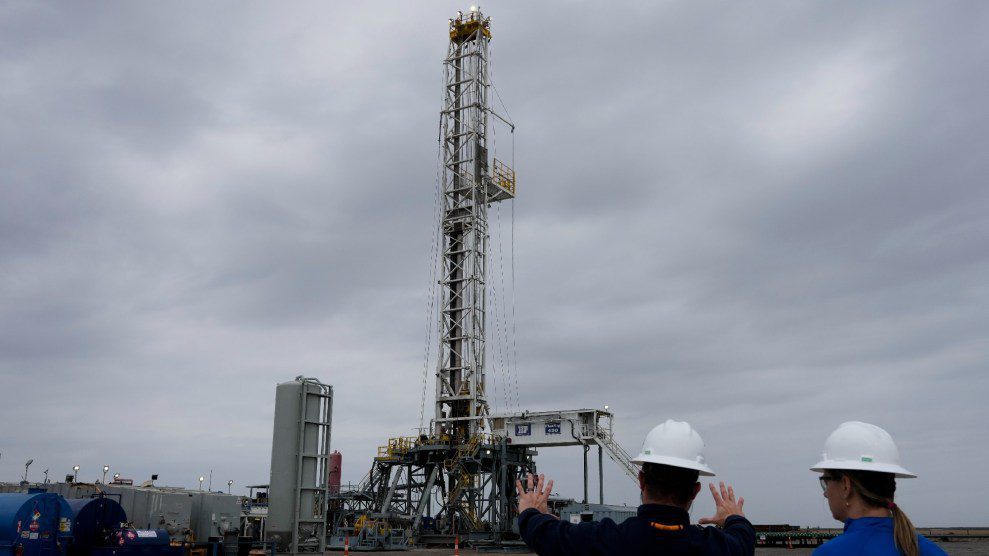
A Chevron drilling rig designed to assist in carbon capture.Yi-Chin Lee/Houston Chronicle/Getty Images
This story was originally published by WIRED and is reproduced here as part of the Climate Desk collaboration.
Over the past few years, the United States has become the go-to location for companies seeking to suck carbon dioxide out of the sky. There are a handful of demonstration-scale direct air capture (DAC) plants dotted across the globe, but the facilities planned in Louisiana and Texas are of a different scale: They aim to capture millions of tons of carbon dioxide each year, rather than the dozens of tons or less captured by existing systems.
The US has a few things going for it when it comes to DAC: It has the right kind of geological formations that can store carbon dioxide pumped underground, it has an oil and gas industry that knows a lot about drilling into that ground, and it has federal grants and subsidies for the carbon capture industry. The projects in Louisiana and Texas are supported by up to $1.05 billion in Department of Energy (DOE) funds, and the projects will be eligible for tax credits of up to $180 per ton of carbon dioxide stored.
“It’s quite clear that the United States is the leader in policy to support this nascent sector,” says Jason Hochman, executive director at the Direct Air Capture Coalition, a nonprofit that works to accelerate the deployment of DAC technology. “At the same time, it’s nowhere near where it needs to be to get on track—to the scale we need to get to net zero.”
The Heritage Foundation doesn’t just doubt the carbon removal industry—it is openly skeptical about climate change
But support for carbon storage is far from guaranteed. Project 2025, the nearly thousand-page Heritage Foundation policy blueprint for a second Trump presidency, would dramatically roll back policies that support the DAC industry and carbon capture more generally. The Project 2025 Mandate for Leadership document proposes eliminating the DOE’s Office for Clean Energy Demonstrations, which provides funds for DAC facilities and carbon capture projects, and also calls out the 45Q tax credit that supports DAC as well as carbon capture, usage, and storage—filtering and storing carbon dioxide emitted by power plants and heavy industry. (The Heritage Foundation did not respond to WIRED’s request for comment.)
Sucking carbon out of the sky is not uncontroversial—not least because of the oil and gas industry’s involvement in the sector—but the Intergovernmental Panel on Climate Change’s Sixth Assessment Report says that using carbon dioxide removal to balance emissions from sectors like aviation and agriculture is unavoidable if we want to achieve net zero. Carbon dioxide removal can mean planting trees and sequestering carbon in soil, but a technology like DAC is attractive because it’s easy to measure how much carbon you’re sequestering, and stored carbon should stay locked up for a very long time, which isn’t necessarily the case with forests and soil.
As DAC technology is so new, and the facilities constructed so far are small, it’s still extremely expensive to remove carbon from the atmosphere this way. Estimated costs for extracting carbon go from hundreds of dollars per ton to in excess of $1,000—although Google just announced it is paying $100 for DAC removal credits for carbon that will be sequestered in the early 2030s. On top of that, large-scale DAC plants are likely to cost hundreds of millions to billions of dollars to build.
That’s why government support like the DOE Regional DAC Hubs program is so important, says Jack Andreasen at Breakthrough Energy, the Bill Gates–founded initiative to accelerate technology to reach net zero. “This gets projects built,” he says. The Bipartisan Infrastructure Law signed in 2021 set aside $3.5 billion in federal funds to help the construction of four regional DAC hubs. This is the money that is going into the Louisiana and Texas projects.
Climeworks is one of the companies working on the Louisiana DAC hub, which is eligible for up to $550 million in federal funding. Eventually, the facility aims to capture more than 1 million tons of carbon dioxide each year and store it underground. “If you do want to build an industry, you cannot do it with demo projects. You have to put your money where your mouth is and say there are certain projects that should be eligible for a larger share of funding,” says Daniel Nathan, chief project development officer at Climeworks. When the hub starts sequestering carbon, it will be eligible to claim up to $180 for each ton of carbon stored, under tax credit 45Q, which was extended under the Inflation Reduction Act.
“You cannot start an industry with a societal good in mind unless you get governments to take an active role.”
These tax credits are important because they provide long-term support for companies actually sequestering carbon from the atmosphere. “What you have is a guaranteed revenue stream of $180 per ton for a minimum of 12 years,” says Andreasen. It’s particularly critical given that the costs of capturing and storing a ton of carbon dioxide are likely to exceed the market rate of carbon credits for a long time. Other forms of carbon removal, notably planting forests, are much cheaper than DAC, and removal offsets also compete with offsets for renewable energy, which avoid emitting new emissions. Without a top-up from the government, it’s unlikely that a market for DAC sequestration would be able to sustain itself.
Most of the DAC industry experts WIRED spoke to thought there was little political appetite to reverse the 45Q tax credit—not least because it also allows firms to claim a tax credit for using carbon dioxide to physically extract more oil from existing reservoirs. They were more worried, however, about the prospect that existing DOE funds set aside for DAC and other projects might not be allocated under a future administration.
“I do think a slowing down of the DOE is a possibility,” says Andreasen. “That just means the money takes longer to get out, and that is not great.” Katie Lebling at the World Resources Institute, a sustainability nonprofit, agrees, saying there is a risk that unallocated funds could be slowed down and stalled if a new administration looked less favorably on carbon removal.
The Heritage Foundation doesn’t just doubt the carbon removal industry—it is openly skeptical about climate change, writing in one report that observed warming could only “theoretically” be due to the burning of fossil fuels, and that “this claim cannot be demonstrated through science.” In its Project 2025 plan, the foundation says the “government should not be picking winners and losers and should not be subsidizing the private sector to bring resources to market.”
But without government support, the private sector would never develop technologies like DAC, says Jonas Meckling, an associate professor at UC Berkeley and climate fellow at Harvard Business School. The same was true of the solar industry, Meckling says. “You cannot start an industry with a societal good in mind unless you get governments to take an active role,” says Nathan of Climeworks.
While there are some question marks over the future of DOE grants for DAC, the industry appeals to legislators on both sides of the aisle. The Texas DAC hub is being built by 1PointFive, a subsidiary of Occidental Petroleum, and both DOE projects are located in firmly red states. When it was announced that DOE DAC hubs funding would be spent in Louisiana, Senator Bill Cassidy said: “Carbon capture opens a new era of energy and manufacturing dominance for Louisiana. It is the future of job creation and economic development for our state.”
In the long run, Nathan says, the aim is for DAC to be viable on its own economic terms. In time, he says, that will mean regulation that requires industries to pay for carbon removal—a stricter version of emissions-trading schemes that already exist in places like California and the European Union. Eventually, that should lead to a place where the direct air industry no longer requires government support to remove carbon from the atmosphere at scale. “I’m looking at the fundamentals, and those aren’t driven by who’s in office,” Nathan says
Source link : http://www.bing.com/news/apiclick.aspx?ref=FexRss&aid=&tid=66ed48c60f5f4b8cb798a3ab5b3d0167&url=https%3A%2F%2Fwww.motherjones.com%2Fpolitics%2F2024%2F09%2Fproject-2025-federal-subsidies-carbon-removal-direct-air-capture%2F&c=12940940047728557914&mkt=en-us
Author :
Publish date : 2024-09-19 23:00:00
Copyright for syndicated content belongs to the linked Source.
